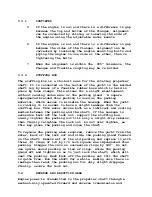
5.8.2
CONTINUED
stop control. To stop the engine the stop control is pulled out
a couple of inches and held in that position till the engine
ceases to run. It is then pushed back to the retracted position.
to run.
5.8.3
INSTRUMENTS
Engine instruments for the diesel consist of warning lamps for
low oil pressure and no-charging condition, temperature gauge,
tachometer, key switch, switch for instrument lighting, fuel
gauge and a spare switch. The key switch is used to start the
engine. Glowing of the oil or amp lights indicates low oil
pressure and a no charge condition respect1vely. To check the
lamps, turn the key to the accessory position where the lamps
should glow. The actual degree of charging can also be
ascertained from the Battery Condition Meter as described in
Section 4.1.2. Temperature of the Volvo Penta MD6B is
thermostatically controlled. Under normal operating conditions
the temperature gauge should indicate in the green region. The
tachometer indicates the speed of the engine in revolutions per
minute. Due to s11ppage, loading, wind and sea conditions, there
is no exact correlation of the engine RPM’s to the yacht’s
speed. However, general correlation can be established for
normal operating conditions. The spare switch is connected
through a fuse block located behind the instrument panel
accessible through the main cabin behind the companionway
ladder.
5.8.4
BREAK IN PROCEDURE
The break in procedure is the same as for the gasoline engine,
except that the break in and oil change period is 20 hours
instead of 10 hours.
5.8.5
RUNNING THE ENGINE
When starting the engine turn the key to the accessory position.
The "Amp" and "Oil" lights should glow, then continue to turn
the key to the start position.
Although the Volvo Penta MD6B engine can be run at a full speed
of about 2,400 RPM, this mode of operation should be restricted
to periods of no longer than 15 minutes of each hour. The
recommended continuous cruising speed is about 2,100 RPM.
Extended idle periods should be avoided whenever possible. In
cases where the engine must idle for long periods of time is
recommended that cruising speed be obtained for a five minute
period once each hour if at all possible.
Summary of Contents for 299
Page 1: ......
Page 2: ......
Page 53: ......
Page 54: ......
Page 55: ......
Page 56: ......
Page 57: ......
Page 58: ......
Page 59: ......
Page 60: ......
Page 61: ......
Page 62: ......
Page 63: ......
Page 64: ......
Page 65: ......
Page 66: ......
Page 67: ......
Page 68: ......
Page 69: ......
Page 70: ......
Page 71: ......
Page 72: ......
















































